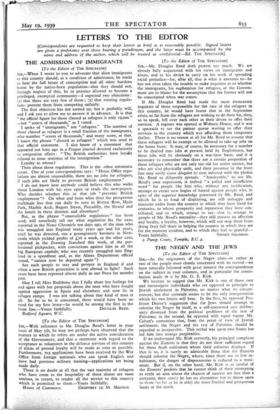THE NEGEV AND THE JEWS
[To the Editor of THE SPECTATOR] SIR,—As the originators of the Negev plan—or rather as two of the people most closely concerned with its revival—we have naturally followed with great interest the correspondence on the subject in your columns, and in particular the contri- bution made te it by Mr. G. E. Kirk.
We hesitate to suggest that Mr. Kirk is one of those rare and intransigent individuals who are opposed in principle to Jewish settlement in Palestine, no matter what its circum- stances; but that certainly seems to be the only interpretation which his two letters will bear. In the first, he opposed Pro- fessor Driver's suggestion that the Jews should attempt to colonise the Negev by itself, as a self-contained unit deliber- ately divorced from the political problems of the rest of Palestine; in the second, he opposed with equal vigour Mr. Cohen's contention that, from the point of view of Jewish settlement, the Negev and the rest of Palestine should be regarded as inseparable. This verbal war upon two fronts has led him into strange perplexities.
If we understand Mr. Kirk correctly, his principal complaint against the Zionists is that they do not show sufficient regard for those Arab cultivators whom their colonists displace. If that is so, it is surely an admirable thing that the Zionists should colonise the Negev, where, since there are so few in- habitants, the danger of dispossession is reduced to a mini- mum. But if, on the other hand, Mr. Kirk is so careful of the Zionists' pockets that he cannot think of their attempting to settle an area where the chances of success are less than a certainty, then surely he has no alternative but to throw open to them (so far as he is able) the more fruitful and prosperous lands of the north.
However, there is this much to be said for Mr. Kirk's point of view : were it really known that the Negev was uncultivable and uninhabitable, it would indeed be an act of common humanity to warn the Zionists of that fact. If they heeded the warning, their future activities would then be confined to northern Palestine and open, no doubt, to all the objections that Mr. Kirk has noted. They would be left, in fact, with two alternatives—to do nothing or to do wrong; and we cannot feel that Mr. Kirk would willingly condemn even Zionists to this fate except on absolutely unquestionable evidence.
For this reason we do not think that he will take it amiss if we conclude this letter by pointing out one or two errors that he has unwittingly made in his references to the Negev. In the first place, the Negev is not known officially as "the Southern District of Palestine." When, in official documents, it is not called the Negev, it is always referred to as "the Beersheba sub-district." Secondly, the mountains of the Negev are, correctly speaking, a continuation of the Sinai range, rather than of the Judaean highlands ; the maximum height attained is not 2,500 feet, but 3,310 feet at the peak of the G. el Khorasha. It has also, perhaps, escaped Mr. Kirk's attention that the hill-districts of the Negev are by no means uninhabitable; even in the uplands of the G. Magra the ruins of some seventeen Byzantine villages are to be found, at an altitude of anything up to 2,500 feet.
The next point concerns the rainfall. As Mr. Kirk rightly remarks there is no certainty that the rainfall is as great today as it was in Byzantine times. This is natural enough, for the statistics concerning present-day rainfall are wholly inade- quate, and those concerning the rainfall in Byzantine times are non-existent. The best that one can say is that, in the opinion of the best meteorologists, there has been no general deterior- ation in the climate of the Near East, and permanent local variations are rare. Mr. Kirk does indeed mention that the present annual average rainfall at Auja Hafir is only five inches; but we do not know what authority he can quote in support of this statement. No expert will undertake to cal- culate an annual average of rainfall except on the basis of observation extending over at least 28 years. The obser- vations at Auja Hafir are now entering their fourth year and it is interesting to note that last year they recorded 284.5 mm., that is approximately 11.5 inches, or rather over twice Mr. Kirk's figure. By the same token, his remark that the rainfall of the Negev decreases to the south and east of Auja is very hard to understand; the only rainfall observation-post south-east of Auja Hafir is Petra, which has recorded a density of 202.83 mm. for the last three years..
Fifthly, and lastly, we come to the question of population.
Mr. Kirk disputes Professor Driver's claim that the present population of the Negev does not exceed five thousand per- sons, and quotes in his support a gentleman to whom he refers as " Arif el Arif, the Governor of the Southern District." Now it is perfectly true that Aref Eff. el Aref, the Administrative Officer at Beersheba, did provide the statistics for the Beersheba sub-district on which the last Palestine Census Report was based. To this entry, however, the Report adds the following foot-note; "It is only fair to state that Aref Eff. el Aref thinks that on the whole he short- counted the nomadic population by about 20 per cent. The sample examination, however, very obviously does not support his opinion." Does this, perhaps, also explain how Mr. Kirk came to be led astray?—Yours faithfully, T. Zissu.
J. W. A. GWYER.
[We cannot continue this correspondence.—En. The Spectator.]



















































 Previous page
Previous page